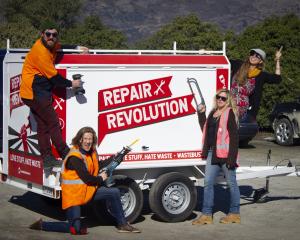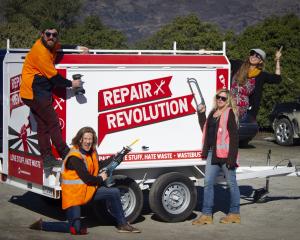
It is not the pitfalls that are meant to he circular, writes Gina Dempster.

It's been a crazy year for waste and recycling. There's never been so much momentum to tackle plastic pollution, New Zealand's upcoming ban on plastic bags is just one example of changing attitudes. At the same time, China shutting its doors to recycling has caused a crash in prices and stockpiling of recycling around the world. It's like a perfect storm, revealing the cracks in the way the world deals with waste.
Until now, the out-of-sight, out-of-mind approach has more or less worked for us. Once we've put something in our recycling or rubbish bin, we feel we've done our bit. Away it goes - to the landfill or to China - and we never have to think about it again. Or so it seemed, until plastics started seeping out on to beaches, into the food chain and massive "gyres" where microscopic plastic collects in the oceans.
A study published in Science Advances in June found that only 9% of plastic waste has been recycled globally; the overwhelming majority of plastic waste (80%) going to landfills or contaminating the environment. And unless we do something quickly, the flood of plastic is going to turn into a tsunami.
This week, I watched an ABC documentary called The Tipping Point, which followed a rubbish picker and a food delivery driver in China. Each day, 60 million plastic containers are thrown away in China. Every single day!
If we don't come up with a better system than make-use-throw away, we're going to pollute the planet to a point from which there is no coming back. I know we're all busy and that it's easier to throw things away than to take them home, wash them and remember to take them the next time. But we have to change, and that means not just changing what we do as individuals but changing the recycling system and the production system and the way we design things.
People are trying to figure out a new way of thinking about resources; the circular economy. Recycling is an integral part of the circular economy, so that "technical" materials (such as glass and metal) can be recaptured and used again. We need to make sure that recycling is viable in the future, both technically and economically.
For recycling to be viable, recyclers have to make enough money to cover costs. The recycled materials have to be useful in the production of something new. If these basic requirements can't be met, recycling is broken and will either fall over in the long-run or end up being green-wash, in which people will eventually lose faith.
Obviously, recycling can't solve all our waste problems on its own. We have to rethink our prioritisation of convenience over the health of the planet. And we urgently have to break our addiction to single-use plastic. But if we want recycling to be ready to play its part in the circular economy, we also need to work on building a functional and robust recycling system.
The building blocks of a functional recycling system
1. DESIGN FOR RECYCLING
Recyclers are the ambulance at the bottom of the cliff, we do the best we can with all the crap that's been thrown over the top. Designers are in the driver's seat because they choose what materials are used and how they are combined.
Designing for materials to be retrieved at the end of a product's life needs to be as important to the design process as how it performs and how it looks. That includes choosing materials that fit into the recycling loop.
2. THE PUSH FOR RECYCLING
Generally, people love recycling and put effort into separating their recycling and putting it out at the kerbside. The goodwill is there, but it won't survive endless stories about recycling being contaminated or going to landfill.
People need to have faith in the recycling system, which means the recycling system needs to be designed and funded in a sustainable and transparent way. And we need to tell the truth about what's happening with our recycling.
3. THE PULL FOR RECYCLING
The definition of recycling is to "convert waste into reusable material". For it to be viable in the long-term, there has to be a demand for the recycled material to make something new with it. It's no good having a massive flow of recycled materials if no-one wants to buy the end product into which they have been made.
4. ONSHORE REPROCESSING
China's National Sword policy to close the gate to contaminated recycling has shown how vulnerable fully offshore systems are.
Setting up more onshore recycling makes the system more robust, transparent and visible. It makes it much easier for everyone in the recycling chain to talk to each other about how to make the recycling chain work.
A task force within the Ministry for the Environment has been set up to look at the best response to the recycling crisis, with advice from councils and recyclers. Development of more onshore reprocessing is one of the options on the table.
5. COLLECTING AND SORTING RECYCLING
For years China was prepared to take contaminated recycling and sort it out. As soon as they stopped doing that, the world's recycling started building up in dirty stockpiles.
We need to rethink our collection and handling systems, so that we reduce contamination and fund recyclers to do the job properly.
Councils are struggling with the burden of funding kerbside recycling in New Zealand, and commingled collection systems have led to high rates of contamination. Introducing a container deposit-refund system would tackle all those problems at once
How container deposit-refund systems could help
Container deposit-refund systems lead to extremely high recycling rates (up to 99% in Germany) and extremely low contamination rates. They also achieve extremely low litter rates; after all, most of us will pick up 10c if we see it lying in the street.
In Norway, 97% of all plastic bottles are recycled, 92% to such a high standard they are turned back into drink bottles.
The Kiwi Bottle Drive campaign is collecting signatures on a petition for a container deposit-refund scheme in New Zealand. If you think it's a good idea, go to www.wastebusters.co.nz to add your name.
 DDPE (NO2 plastic) used in milk bottles is one of the few plastics that can be recycled onshore, at Comspec in Christchurch. Photo: Si Williams
RECYCLING NEWS FROM THIS MONTH: THE GOOD AND THE BAD
DDPE (NO2 plastic) used in milk bottles is one of the few plastics that can be recycled onshore, at Comspec in Christchurch. Photo: Si Williams
RECYCLING NEWS FROM THIS MONTH: THE GOOD AND THE BAD

This month Lewis Road Creamery started putting all its milk in 750ml and 1.5-litre bottles made from 100% recycled PET plastic (rPET). Until now, recycled plastic has often been avoided by manufacturers because it has visual imperfections. However, with changing attitudes, marketers are now reframing that as an advantage.
Lewis Road Creamery put it like this: "As our milk bottles go greener, you may also notice a slightly opaque look to the range. This change in colour is simply down to the fact that we are using recycled plastics and we'll wear our new opaque look with pride."
Also this month, the Packaging Forum confirmed that all the soft plastics being collected around the country in the Soft Plastics Recycling bins are being stockpiled rather than recycled.
The scheme only collects a tiny proportion of the soft plastics used in New Zealand, but even that has overwhelmed the Australian company that turns the plastic into park benches and bollards, due to lack of demand for its products.
Recycling schemes have to be robust enough to deal with high volumes of material, otherwise they can be seen as tokenistic or green-wash, and will cause people to lose faith in recycling.












